In the domain of contemporary physics and biological sciences, a provocative question emerges: Is life, in its myriad forms, an electromagnetic field? This inquiry invites a fusion of concepts from physics, biology, and philosophical discourse. The idea encourages us to contemplate the fundamental nature of life, motivating exploration into the intricate relationships between electromagnetic phenomena and living organisms. This article will delve into the various dimensions of this question, structuring our exploration into multiple sections that encompass the electromagnetic spectrum, the biophysical basis of life, cellular bioelectromagnetics, and the implications of viewing life through the lens of electromagnetic fields.
At the outset, it is essential to delineate the principles of electromagnetic fields. An electromagnetic field consists of electric and magnetic components that are interrelated and propagate through space. These fields manifest at various frequencies within the electromagnetic spectrum—from low-frequency radio waves to high-frequency gamma rays. The ubiquitous presence of electromagnetic fields in technology and nature indicates that they are essential components of the universe. This raises the question of whether these fields can be seen as more than passive entities. Could they serve a critical role in the energetics of biological systems? This notion paves the way for interdisciplinary inquiry.
The biophysical foundation of life is predicated upon the interplay of chemical and physical processes. The molecular complexity of life arises from the interactions of atoms and molecules, particularly organic compounds. Electromagnetic phenomena significantly influence these biochemical pathways. For instance, the absorption of light by chlorophyll enables photosynthesis, a process that undergirds the energy requirements of nearly all life forms on Earth. Additionally, various electromagnetic signals orchestrate cellular communication, suggesting that life may harness electromagnetic properties in pivotal biological processes.
Delving into cellular bioelectromagnetics, we uncover how living cells generate and respond to various electromagnetic fields. Within cells, ionic channels and membranes establish electric potentials, resulting in oscillations that can be conceptualized as bioelectromagnetic fields. Neurons, for instance, utilize changes in membrane potential to transmit signals, culminating in complex behaviors and interactions. This bioelectric phenomenon raises pertinent questions about the extent to which life operates within the constraints of electromagnetic principles.
This perspective aligns with emerging research on the impact of electromagnetic fields on living organisms. Studies investigating the effects of external electromagnetic fields on biological systems have garnered significant attention. For example, research on how exposure to specific frequencies may influence cellular repair mechanisms establishes a compelling narrative linking electromagnetic fields with vital biological processes. Additionally, the implications of such interactions can extend to broader biological phenomena, including the migratory patterns of species that utilize Earth’s geomagnetic field for navigation. Such observations hint at an intricate relationship between biology and the electromagnetic environment, further supporting the notion of life as influenced by electromagnetic fields.
Philosophically, contemplating life as an electromagnetic field leads to profound implications regarding the nature of consciousness and existence. If life can indeed be interpreted as an electromagnetic phenomenon, we might posit that consciousness arises from a complex interplay of electromagnetic interactions. The quest to understand consciousness through the paradigms of physics could redefine traditional notions of sentience and self-awareness. Here, one might ponder the implications for concepts such as free will and the essence of being, particularly as technological advancements blur the lines between artificial intelligence and biological life.
Moreover, the concept of life as an electromagnetic field allows for a novel interpretation of health and wellness. Traditional medicine often focuses on biochemical pathways, yet a bioelectromagnetic perspective could enhance therapeutic approaches, suggesting that optimizing the electromagnetic environment may have healing properties. Techniques such as biofeedback, electromagnetic therapy, and alternative practices rooted in energy healing resonate with this ethos, providing avenues for further inquiry into the interconnectedness of health and electromagnetic interactions.
Transitioning to the ecological aspect, viewing life as an electromagnetic field informs our understanding of the interconnected networks that constitute ecosystems. Each organism, through its bioelectromagnetic field, interacts not merely with its immediate environment but also influences and is influenced by myriad other organisms and ecological processes. This holistic perspective supports the emergent field of bioelectromagnetics in ecology, where the interactions between organisms and their environment, mediated by electromagnetic phenomena, are elucidated. The implications for biodiversity and ecosystem health are significant, as understanding these interactions may aid in conservation efforts and the sustainability of natural systems.
The ramifications of this inquiry extend to the future of scientific exploration. The intersection of biology and electromagnetism represents a fertile ground for interdisciplinary research, inviting collaboration across diverse fields, including physics, biology, bioengineering, and medicine. Continued investigation into the mechanisms through which electromagnetic fields affect biological systems promises to yield novel insights that could redefine our understanding of life itself. As researchers delve deeper into the dynamics of bioelectromagnetics, we may unveil underlying principles that govern not only cellular function but also broader biological phenomena.
In conclusion, the exploration of whether life can be conceptualized as an electromagnetic field invites a reevaluation of fundamental scientific principles. Through examining the intricate interplay between electromagnetic phenomena and biological processes, we deepen our understanding of life’s complexity. This perspective does not merely serve as an academic exercise; rather, it holds the potential to transform our relationship with the natural world. As we grapple with the profound implications of this question, we remain bound by our curiosity and desire to unveil the secrets of life that lie at the intersection of science and philosophy.












